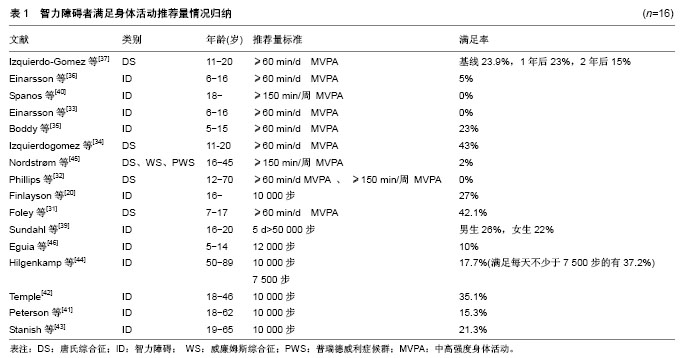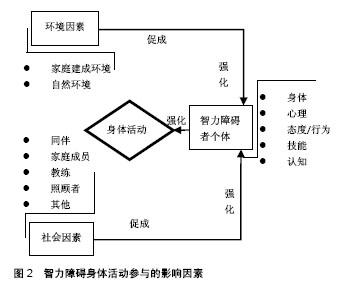| [1] Katikireddi SV. Global, regional, and national incidence and prevalence, and years lived with disability for 328 diseases and injuries in 195 countries, 1990-2016: A systematic analysis for the global burden of disease study 2016. Lancet. 2017;390(10100):1211-1259.
[2] 冬雪. 美国智力障碍定义的演变及其启示[J]. 中国特殊教育,2011,(5): 34-39.
[3] Walsh PN, Kerr M, van Schrojenstein Lantman-de-Valk HM. Health indicators for people with intellectual disabilities: A european perspective. Eur J Public Health. 2003;13(S3): 47-50.
[4] Krahn GL, Hammond L, Turner A. A cascade of disparities: Health and health care access for people with intellectual disabilities. Ment Retard Dev Disabil Res Rev. 2006;12(1):70-82.
[5] Martin E, Mckenzie K, Newman E, et al. Care staff intentions to support adults with an intellectual disability to engage in physical activity: An application of the theory of planned behaviour. Res Dev Disabil. 2011;32(6):2535-2541.
[6] Pauline H, Gyles G. Mortality of people with intellectual disabilities in england: A comparison of data from existing sources. J Appl Res Intellect Disabil. 2015;28(5):414-422.
[7] Caspersen CJ, Powell KE, Christenson GM. Physical activity, exercise, and physical fitness: Definitions and distinctions for health-related research. Public Health Rep. 1985;100(2):126-131.
[8] Duplant A, Vingren J, Kellerl J. Physical activity and intellectual disability. Strength & Conditioning Journal. 2014;36(2): 26-28.
[9] Bartlo P, Klein PJ. Physical activity benefits and needs in adults with intellectual disabilities: Systematic review of the literature. Am J Intellect Dev Disabil. 2011;116(3):220-232.
[10] Willems M, Hilgenkamp TI, Havik E, et al. Use of behaviour change techniques in lifestyle change interventions for people with intellectual disabilities: A systematic review. Res Dev Disabil. 2016; 60:256-268.
[11] Brooker K, Van DK, Mcpherson L, et al. A systematic review of interventions aiming to improve involvement in physical activity among adults with intellectual disability. J Phys Act Health. 2015;12(3): 434-444.
[12] Finlay WM, Lyons E. Methodological issues in interviewing and using self-report questionnaires with people with mental retardation. Psychol Assess. 2001;13(3):319-335.
[13] 戴剑松,孙飙. 体力活动测量方法综述[J]. 体育科学, 2005,25(9): 69-75.
[14] Mcgarty AM, Penpraze V, Melville CA. Accelerometer use during field-based physical activity research in children and adolescents with intellectual disabilities: A systematic review. Res Dev Disabil. 2014;35(5): 973-981.
[15] 王超,贺刚,李建忠,等.残疾青少年体力活动水平及其与运动自我效能的关系:基于加速度计的初步研究[J].首都体育学院学报, 2016, 28(4): 380-384.
[16] Biddle SJ, Gorely T, Stensel DJ. Health-enhancing physical activity and sedentary behaviour in children and adolescents. J Sports Sci. 2004; 22(8): 679-701.
[17] Thomas JR, Nelson JK, Silverman SJ/李红娟, 花勇民, 郜艳晖译. 体力活动研究方法[M]. 6版.北京:北京体育大学出版社, 2016:180.
[18] Johnson M, Yun J, Mccubbin JA. Validity evidence for self-report with assistance to measure physical activity behavior in adults with intellectual disabilities. Intellect Dev Disabil. 2014;52(4):273-281.
[19] Dairo YM, Collett J, Dawes H. A feasibility study into the measurement of physical activity levels of adults with intellectual disabilities using accelerometers and the international physical activity questionnaire. British J Learning Disabil. 2017; 20(45): 129-137.
[20] Finlayson J, Turner A, Granat MH. Measuring the actual levels and patterns of physical activity/inactivity of adults with intellectual disabilities. J Appli Res Intellect Disabil. 2011; 24(6): 508-517.
[21] Mahy J, Shields N, Taylor NF, et al. Identifying facilitators and barriers to physical activity for adults with down syndrome. J Intellect Disabil Res. 2010; 54(9): 795-805.
[22] Black DP, Smith BA, Wu J, et al. Uncontrolled manifold analysis of segmental angle variability during walking: Preadolescents with and without down syndrome. Exp Brain Res. 2007; 183(4): 511-521.
[23] Carr J. Mental and motor development in young mongol children. J Ment Defic Res. 2010;14(3): 205-220.
[24] Agiovlasitis S, Motl RW, Fahs CA, et al. Metabolic rate and accelerometer output during walking in people with down syndrome. Med Sci Sports Exerc. 2011; 43(7): 1322-1327.
[25] Agiovlasitis S, Motl RW, Foley JT, et al. Prediction of energy expenditure from wrist accelerometry in people with and without down syndrome. Adapt Phys Activ Q. 2012;29(2):179-190.
[26] Pitchford EA, Yun J. The accuracy of pedometers for adults with down syndrome. Adapt Phys Activ Q. 2010; 27(4):321-336.
[27] Pitchford EA, Yun J. Pedometer variance in adults with down syndrome during free walking: A generalizability study. J Phys Act Health. 2011;8(8):1143-1151.
[28] Tudor-Locke C, Craig CL, Brown WJ, et al. How many steps are enough? For adults. Int J Behav Nutr Phys Act. 2011;8(2):207-211.
[29] Marc A, Johnson, William D, et al. Steps/day translation of the moderate-to-vigorous physical activity guideline for children and adolescents. Int J Behav Nutr Phys Act. 2013; 10(1): 49-49.
[30] Fontana FE, Silva MPD, Marston R, et al. Step-count guidelines referenced on 60-minutes of moderate/vigorous physical activity. Motriz Revista De Educação Física. 2015; 21(1): 92-99.
[31] Foley JT, Mccubbin JA. An exploratory study of after-school sedentary behaviour in elementary school-age children with intellectual disability. J Int Dev Disabil. 2009; 34(1): 3-9.
[32] Phillips AC, Holland AJ. Assessment of objectively measured physical activity levels in individuals with intellectual disabilities with and without down's syndrome. Plos One. 2011; 6(12): e28618.
[33] Einarsson IO, Olafsson A, Hinriksdóttir G, et al. Differences in physical activity among youth with and without intellectual disability. Med Sci Sports Exerc. 2015;47(2):411-418.
[34] Izquierdo-Gomez R, MartãNez-Gã³mez D, Acha A, et al. Objective assessment of sedentary time and physical activity throughout the week in adolescents with down syndrome. The up&down study. Res Dev Disabil. 2014;35(2): 482-489.
[35] Boddy LM, Downs SJ, Knowles ZR, et al. Physical activity and play behaviours in children and young people with intellectual disabilities: A cross-sectional observational study. School Psychology International. 2015; 36(2): 154-171.
[36] Einarsson IÞ, Jóhannsson E, Daly D, et al. Physical activity during school and after school among youth with and without intellectual disability. Res Dev Disabil. 2016; 56:60-70.
[37] Izquierdo-Gomez R, Martinez-Gómez D, Esteban-Cornejo I, et al. Changes in objectively measured physical activity in adolescents with down syndrome: The up&down longitudinal study. J Int Disabil Res. 2017; 61(4): 1-10.
[38] Lante KA, Walkley JW, Gamble M, et al. An initial evaluation of a long-term, sustainable, integrated community-based physical activity program for adults with intellectual disability. J Intellect Dev Disabil. 2011; 36(3): 197-206.
[39] Sundahl L, Zetterberg M, Wester A, et al. Physical activity levels among adolescent and young adult women and men with and without intellectual disability. J Appl Res Intellect Disabil. 2016; 29(1): 93-98.
[40] Spanos D, Hankey CR, Melville CA. The effectiveness of a weight maintenance intervention for adults with intellectual disabilities and obesity: A single stranded study. J Appl Res Intellect Disabil. 2016; 29(4): 317-329.
[41] Peterson JJ, Janz KF, Lowe JB. Physical activity among adults with intellectual disabilities living in community settings. Prev Med. 2008; 47(1):101-106.
[42] Temple VA. Factors associated with high levels of physical activity among adults with intellectual disability. Int J Rehabil Res. 2009; 32(1): 89-92.
[43] Stanish HI, Draheim CC. Walking activity, body composition and blood pressure in adults with intellectual disabilities. J Appl Res Intellect Disabil. 2010; 20(3): 183-190.
[44] Hilgenkamp TI, Reis D, Van WR, et al. Physical activity levels in older adults with intellectual disabilities are extremely low. Res Dev Disabil. 2012 Mar-Apr;33(2):477-483.
[45] Nordstrøm M, Hansen BH, Paus B, et al. Accelerometer-determined physical activity and walking capacity in persons with down syndrome, williams syndrome and prader–willi syndrome. Res Dev Disabil. 2013; 34(12): 4395-4403.
[46] Eguia KF, Capio CM, Simons J. Object control skills influence the physical activity of children with intellectual disability in a developing country: The philippines. J Intellect Dev Disabil. 2015; 40(3): 1-10.
[47] Temple VA. Barriers, enjoyment, and preference for physical activity among adults with intellectual disability. Int J Rehabil Res. 2007; 30(4): 281-287.
[48] Esposito PE, Macdonald M, Hornyak JE, et al. Physical activity patterns of youth with down syndrome. Intellect Dev Disabil. 2012; 50(2): 109-119.
[49] Shields N, Hussey J, Murphy J, et al. An exploratory study of the association between physical activity, cardiovascular fitness and body size in children with down syndrome. Dev Neurorehabil. 2015; 20(2): 92-98.
[50] Queralt A, Vicente-Ortiz A, Molina-García J. The physical activity patterns of adolescents with intellectual disabilities: A descriptive study. Disabil Health J. 2016;9(2):341-345.
[51] Bodde AE, Seo DC. A review of social and environmental barriers to physical activity for adults with intellectual disabilities. Disabil Health J. 2009;2(2):57-66.
[52] Horvat M, Pitetti KH, Croce R. Isokinetic torque, average power, and flexion/extension ratios in nondisabled adults and adults with mental retardation. J Orthop Sports Phys Ther. 1997; 25(6): 395-399.
[53] Morris CA, Demsey MSA, Leonard CO, et al. Natural history of williams syndrome: Physical characteristics. J Pediatr. 1988; 113(2): 318-326.
[54] Korenberg JR, Chen XN, Schipper R, et al. Down syndrome phenotypes: The consequences of chromosomal imbalance. Proc Natl Acad Sci U S A. 1994;91(11):4997-5001.
[55] Amaro AS, Mesquita MLGD, Rodrigues GM, et al. Physiological adaptation after a 12-week physical activity program for patients with prader–willi syndrome: Two case reports. J Med Case Rep. 2016; 10(1):181-187.
[56] Morris CA, Mervis CB, Paciorkowski AP, et al. 7q11.23 duplication syndrome: Physical characteristics and natural history. Am J Med Genet A. 2016; 167(12): 2916-2935.
[57] Schlosser RW, Wendt O, Bhavnani S, et al. Use of information-seeking strategies for developing systematic reviews and engaging in evidence-based practice: The application of traditional and comprehensive pearl growing. A review. Int J Lang Commun Disord. 2006;41(5):567-582.
[58] Toomey E, Coote SB. Physical rehabilitation interventions in nonambulatory people with multiple sclerosis: A systematic review. Int J Rehabil Res. 2012; 35(4): 281-291.
[59] Downs SJ, Knowles ZR, Fairclough SJ, et al. Exploring teachers’ perceptions on physical activity engagement for children and young people with intellectual disabilities. Eur J Special Needs Education. 2014; 29(3): 402-414.
[60] Mcgarty AM, Melville CA. Parental perceptions of facilitators and barriers to physical activity for children with intellectual disabilities: A mixed methods systematic review. Res Dev Disabil. 2018; 73:40-57.
[61] Izquierdo-Gomez R, Veiga OL, Villagra A, et al. Correlates of sedentary behaviour in youths with down syndrome: The up&down study. J Sports Sci. 2015; 33(14): 1504-1514.
[62] Hutzler Y, Korsensky O. Motivational correlates of physical activity in persons with an intellectual disability: A systematic literature review. J Intellect Disabil Res. 2010; 54(9): 767-786.
[63] Shields N, Taylor NF, Fernhall B. A study protocol of a randomised controlled trial to investigate if a community based strength training programme improves work task performance in young adults with down syndrome. BMC Pediatr. 2010;10:17.
[64] Shields N, Taylor NF, Wee E, et al. A community-based strength training programme increases muscle strength and physical activity in young people with down syndrome: A randomised controlled trial. Res Dev Disabil. 2013; 34(12): 4385-4394.
[65] Taylor NF. The feasibility of a physical activity program for young adults with down syndrome: A phase ii randomised controlled trial. J Intellect Dev Disabil. 2015; 40(2): 115-125.
[66] Melvill CA, Boyle S, Miller S, et al. An open study of the effectiveness of a multi-component weight-loss intervention for adults with intellectual disabilities and obesity. Br J Nutr. 2011;105(10):1553-1562.
[67] Bodde AE, Seo DC, Frey GC, et al. The effect of a designed health education intervention on physical activity knowledge and participation of adults with intellectual disabilities. Am J Health Promot. 2012; 26(1): 313-316. |
.jpg)


.jpg)
.jpg)